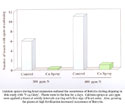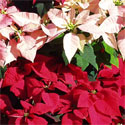Bract Edge Burn
Bract edge burn may cause serious problems in the final weeks of production or following boxing and transport. Bract Edge Burn became a major problem in the late 1970s with the introduction of Gutbier V-14 Glory produced in southern climates. Over the last 10 years, it has become evident that BEB is cultivar-dependent. Bract edge burn symptoms vary among cultivars, but most begin as lesions that serve as points of infection by Botrytis, which will spread and make plants unmarketable.
What is BEB?
Bract edge burn starts with small, brown necrotic lesions along the bract margin and may expand, as a result of Botrytis infection, to damage the entire bract. Low calcium levels in the bract margins appears to be the primary cause of this disorder. It has become apparent that some varieties may have difficulty translocating calcium, an essential element required for cell expansion, to the rapidly expanding bract margins. Consequently, the increased calcium demand cannot be met. Other factors, such as high fertilizer levels, warm finishing temperatures, high shipping temperatures, and long shipping durations also promote the incidence of bract edge burn. Often these stresses weaken the plants where secondary infections from Botrytis can take hold.
Prevention
BEB can't be controlled once lesions appear on the bracts. Growers should use preventive measures to stop crop losses associated with this serious poinsettia disorder. Most important is the need to avoid cultural practices that maximize bract size, but there are other means to prevent and control bract edge burn.
Variety Selection
Some varieties are more susceptible to BEB than others, depending on the calcium levels that occur naturally in bract margins. One of the easiest measures growers can take to prevent BEB is to select a variety that is less susceptible to this disorder.
Click here for a chart of variety performance. (pdf, 11 KB)
Cultural Practices
Fertilizers
Recent work at the University of Florida found that bract edge burn increased twofold as nitrogen concentration increased from 200 ppm to 400 ppm. Poinsettias should receive between 200 to 300 ppm N from a complete fertilizer at every watering, with ammonia and urea nitrogen comprising no more than 30% of the total nitrogen. It is recommended that fertilizer levels be reduced by half or terminated completely during the final two weeks of production to prevent BEB.
Calcium Sprays
 Increasing calcium in the bracts gives added protection against BEB. Calcium must be added during bract expansion-from the very beginning of bract color to marketability. Adding calcium to the growing medium does not reduce bract edge burn; however, weekly foliar/bract sprays, beginning at the first sign of bract color, with 400 mg/l of calcium from calcium nitrate or calcium chloride significantly reduces bract edge burn.
Increasing calcium in the bracts gives added protection against BEB. Calcium must be added during bract expansion-from the very beginning of bract color to marketability. Adding calcium to the growing medium does not reduce bract edge burn; however, weekly foliar/bract sprays, beginning at the first sign of bract color, with 400 mg/l of calcium from calcium nitrate or calcium chloride significantly reduces bract edge burn.
Fungicides
Fungicide sprays are effective in controlling Botrytis associated with BEB, but the residues are unacceptable to most buyers.
Temperature
Using higher night than day temperatures (negative DIF) can increase bract size from 1 to 2 inches, but the incidence of BEB is also increased. Therefore, growers should discontinue the use of negative DIF and use a zero or positive DIF once bract color begins to develop.
Shipping and Transport
Conditions in boxes following sleeving and boxing are conducive to botrytis spread. BEB increases in severity the longer the plants are boxed. Also, bract injury during sleeving and packing immediately after watering or with moist leaves and bracts will increase the chance of serious BEB cases. Plants should not be wet when sleeved and placed in boxes; ideally, plants should be watered the day prior to boxing to ensure moist media with no excessive drainage. Mechanical damage like ripping and tearing of bracts can promote BEB and Botrytis infections. It is also important not to transfer the disease from plant to plant; use caution when removing dead or diseases leaves prior to sleeving. Transport temperatures should be maintained between 55 to 60 F, and plants should be transported for no more than three days.

 Botrytis Infection
Botrytis Infection Botrytis in 'Supjibi'
Botrytis in 'Supjibi' Calcium Deficiency
Calcium Deficiency Necrotic Tips
Necrotic Tips